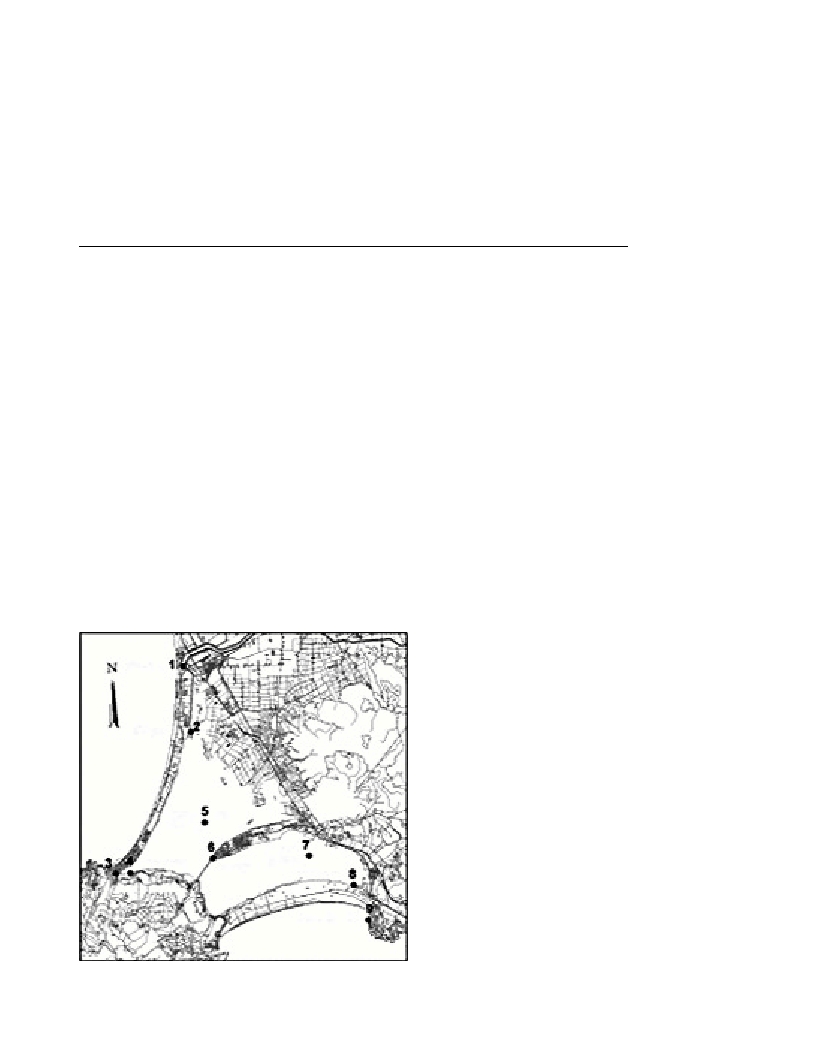Rapp. Comm. int. Mer Médit., 37,2004
140
STUDY OF THE CIRCULATION IN THE ORBETELLO LAGOON, ITALY
Isabella Scroccaro
1*
, Lorenzo Cappietti
2
, Andrea Cappelletti
3
, Georg Umgiesser
1
, Pier Luigi Aminti
2
1
CNR ISMAR - S.Polo, 1364 - 30125 Venice, Italy isabella - * scroccaro@ismar.cnr.it
2
Dip. di Ingegneria Civile – Univ. di Firenze, Via S.Marta, 4 - 50139 Florence, Italy
3
ENEA - Centro Ricerche Ambiente Marino - C.P. 224 - 19100 - La Spezia, Italy
Abstract
The combination of poor hydrodynamic activity and algal blooms in the Orbetello lagoon (Italy) is causing many problems for the water
quality and the conservation of fish population, the most important resource of this ecosystem. To improve the water quality of the lagoon
is necessary to know the hydrodynamic behavior. This goal was achieved using both measurements and numerical simulations, carried out
with a shallow water finite element model, developed at ISMAR-CNR in Venice. The study shows that numerical models could offer a
very useful tool for the management and saveguarding of the water resources.
Keywords: coastal lagoons, hydrodynamic modeling, numerical simulations, Orbetello, finite element method
The Orbetello lagoon (southern coast of Tuscany, Italy) covers an
area of 27 km
2
and is composed of an eastern lagoon (12 Km
2
wide)
and a western lagoon (15 Km
2
wide). The two lagoons are connected
by the Orbetello isthmus and separated by a dam. The average depth
is about 1 meter. The lagoon exchanges water with the Thyrrenian Sea
by three narrow channels: Nassa channel, Fibbia channel and
Ansedonia channel. Each inlet has its own ?oodgate and water pumps
that may pump water from the sea into the lagoon. The lagoon is a
semi-enclose coastal basin characterized by shallow water, poor
hydrodynamic activity, high trophic level and algal blooms, that may
cause problems for the water quality and the conservation of fish
population.
Numerical simulation of the lagoon hydrodynamics was performed
with a shallow water finite element model, developed at ISMAR-CNR
in Venice (1,2). The finite element method gives the possibility to
follow carefully the topography of the system and to better represent
the zones where hydrodynamic activity is more interesting. The model
uses finite elements for spatial integration and a semi-implicit
algorithm for integration in time. Experimental data have been used to
calibrate and validate the numerical model.
A system of gauges was designed in order to collect hydrodynamic
and water quality parameters at different locations. Gauges were
positioned in nine points of the lagoon, as can be seen in Figure 1.
Hydro-meter, Current-meter and multi-parametric gauges, collecting
water temperature, salinity, oxygen and Ph, were put in front of the
channel and in the middle of the lagoon. Wind-meters were put in the
middle of the lagoon, too. Registration of data began in August 2001
and is ongoing. Wind data (speed and direction) and water circulation
data (speed, direction and level) are collected simultaneously every
ten minutes. Moreover, a detailed topographic survey was completed
to precisely map the bathymetry of the lagoon, also revealing the
presence or not of algae. It appeared that in the 90% of the bottom of
the lagoon there was algae presence (3).
Results of the numerical simulations show that the inner
hydrodynamics circulation is mainly due to the wind action. Tidal
excursion was limited to 30 cm in this area and it is not able to induce
appreciable circulation. Algae presence all over the lagoon acts as a
high roughness and is the main factor responsible for low water
circulation in shallow water areas. During typical hydrodynamic
conditions maximum speed velocity is of the order of 1 cm/s.
Some proposals were made, trying to solve the problem of the low-
speed circulation inside the lagoon.
Modification of Ponte Diga: the bridge, which divides the two parts
of the lagoon, has some piers positioned at distances which are not
very large. The proposal was to enlarge the openings on the dam to
assess if this action could improve the circulation (4).
Excavation of channels on the bottom of the lagoon: to increase
the mean water velocity in some particular areas of the lagoon, it is
possible to excavate some channels; these are preferential ways for the
water forced by wind to pass in, and arrive to the areas in which
circulation has to be increased. This proposal seemed to be efficient,
with good effects on the inner circulation of the lagoon.
The next application will be the implementation of a diffusion-
reaction and radiative module to investigate the distribution of
salinity, temperature and oxygen, which play an important role in the
trophic processes of the lagoon.
References
1-Umgiesser, G. and Bergamasco, A., 1993. A staggered grid finite
element model of the Venice Lagoon, In: K. Morgan, E. Ofiate, J. Periaux
and Zienckiewicz, O.C. (eds), Finite Elements in Fluids. Pineridge Press.
2-Umgiesser, G. and Bergamasco, A., 1995. Outline of a Primitive
Equations Finite Element Model. Pp. 291-320. In : Rapporto e Studi, vol.
XII, Venice, Italy, Istituto Veneto of Scienze, Lettere ed Arti.
3-Aminti, P.L., Cappietti, L., Tecchi, M.G., and Venturini, A., 2003.
Hydrodynamics of lagoons, a case of study: the Orbetello Lagoon. Pp.
2031-2042. In : E. Ozhan (Ed.). Proceedings of the Sixth International
Conference on the Mediterranean Coastal Environment, MEDCOAST 03.
4-Scroccaro, I., Cappelletti, A. and Umgiesser, G., 2003. An idealized
circulation of the Orbetello lagoon. Pp. 2087-2098. In : E. Ozhan (Ed.).
Proceedings of the Sixth International Conference on the Mediterranean
Coastal Environment, MEDCOAST 03.
Fig. 1. Position of the gauges. 1-4-6-9 Hydro-meter, 2-3-8 Hydro-meter;
current-meter; multi-parametric gauge, 5-7 Hydro-meter; current-meter;
multi-parametric gauge; wind-meter.

